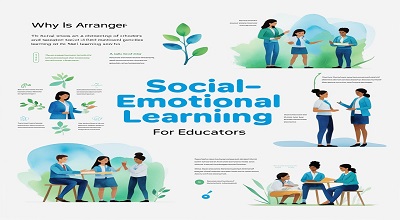SEL for Educators
SEL for Educators: Social and Emotional Learning (SEL) has become a cornerstone of modern education, helping students develop essential life skills such as self-awareness, empathy, and responsible decision-making. For educators, understanding and implementing SEL strategies is crucial for fostering a positive classroom environment and improving student outcomes.
In this comprehensive guide, we will explore the latest SEL strategies for educators, provide real-world examples, and discuss best practices for integrating SEL into daily teaching.
What is Social and Emotional Learning (SEL)?
Social and Emotional Learning (SEL) is an educational framework that helps students develop interpersonal skills, emotional intelligence, and self-regulation. The Collaborative for Academic, Social, and Emotional Learning (CASEL) defines SEL as the process through which individuals acquire and apply knowledge, attitudes, and skills to:
- Understand and manage emotions
- Set and achieve positive goals
- Feel and show empathy for others
- Establish and maintain healthy relationships
- Make responsible decisions
Why SEL Matters in Education
Research shows that SEL improves academic performance, reduces behavioral issues, and enhances mental well-being. Educators play a pivotal role in embedding SEL into classroom culture.
Why is SEL Important for Educators?
Educators who integrate SEL into their teaching practices experience:
- Improved Classroom Management – Students with strong SEL skills exhibit better behavior.
- Enhanced Student Engagement – Emotionally supportive classrooms boost participation.
- Higher Academic Achievement – SEL fosters focus and perseverance.
- Stronger Teacher-Student Relationships – Empathy and communication improve trust.
Example:
A teacher using morning check-ins (asking students how they feel) creates a supportive environment where students feel valued.
Core Competencies of SEL
CASEL outlines five key SEL competencies:
- Self-Awareness – Recognizing emotions and thoughts.
- Self-Management – Regulating emotions and behaviors.
- Social Awareness – Understanding others’ perspectives.
- Relationship Skills – Building healthy interactions.
- Responsible Decision-Making – Making ethical choices.
Example Activity:
- “Emotion Charades” – Students act out emotions to enhance self-awareness and social awareness.
Latest SEL Strategies for Educators
A. Mindfulness Practices
- Deep Breathing Exercises – Helps students manage stress.
- Mindful Listening – Improves focus and empathy.
B. SEL-Integrated Lesson Plans
- Literature Discussions – Analyzing characters’ emotions in stories.
- Role-Playing Scenarios – Practicing conflict resolution.
C. Positive Behavior Reinforcement
- Token Economy Systems – Rewarding positive behaviors.
- Peer Recognition Programs – Encouraging kindness.
Real-World SEL Examples in the Classroom
1: “Feelings Circle”
- Students sit in a circle and share their emotions, fostering empathy.
2: “Conflict Resolution Role-Play”
- Students act out disagreements and practice problem-solving.
3: “Gratitude Journals”
- Students write daily about things they are thankful for, boosting positivity.
How to Assess SEL Progress?
- Student Self-Assessments – Surveys on emotional growth.
- Teacher Observations – Tracking behavioral changes.
- Parent Feedback – Gauging SEL skills at home.
Challenges and Solutions in Implementing SEL
| Challenge | Solution |
|---|---|
| Lack of Time | Integrate SEL into existing lessons |
| Resistance from Staff | Provide professional development |
| Measuring Impact | Use SEL assessment tools |
Future Trends in SEL for Educators
- AI-Powered SEL Tools – Apps that track emotional well-being.
- Trauma-Informed SEL – Supporting students with adverse experiences.
- Global SEL Standards – Unified frameworks for schools worldwide.
FAQs on SEL for Educators
Q1: How can I start implementing SEL in my classroom?
A: Begin with simple activities like emotion check-ins or mindfulness exercises.
Q2: Can SEL improve academic performance?
A: Yes, studies show SEL leads to better focus and higher test scores.
Conclusion
SEL is a transformative approach that equips educators with tools to nurture emotionally intelligent, resilient students. By incorporating the latest SEL strategies, teachers can create inclusive, supportive learning environments that benefit both academic and personal growth.
